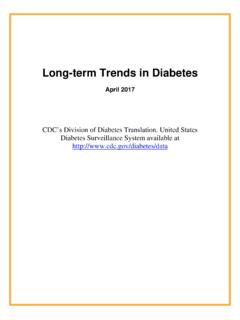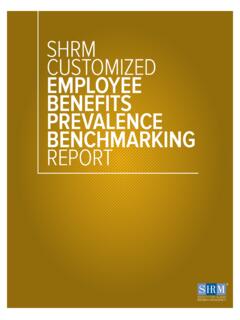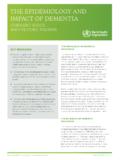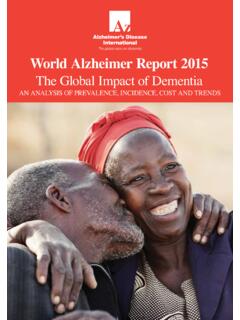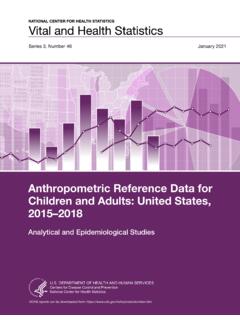Transcription of 2. DRUG STATISTICS AND TRENDS - United Nations Office on ...
1 2. DRUG STATISTICS AND Understanding the extent and nature of drug use123 Globally, UNODC estimates that between 155 and 250 million people, or to of the population aged 15-64, had used illicit substances at least once in the previous year. Cannabis users comprise the largest number of illicit drug users (129-190 million people). Amphetamine-type stimulants are the second most com-monly used illicit drugs, followed by opiates and cocaine. However, in terms of harm associated with use, opiates would be ranked at the top. A comprehensive understanding of the extent of the drug use problem requires a review of several indicators the magnitude of drug use measured by prevalence (lifetime, annual, past 30 days) in the general popula-tion, the potential of problem drug use as measured by drug use among young people, and costs and conse-quences of drug use measured by treatment demand, drug-related morbidity and mortality.
2 Additionally, to understand the dynamics of drug use in a country or region, it is important to look at the overall drug situa-tion rather than merely the TRENDS for individual drugs. This information helps to discern the extent to which market dynamics (availability, purity and price) have temporarily influenced the use, compared to results of long-term efforts such as comprehensive prevention programmes and other interventions to address the drug use situation. To illustrate, long-term TRENDS in use of different drugs and overall drug use are presented for the United States of America, the United Kingdom, Australia and Spain where trend data over a longer period of time is availa-ble.
3 Although short-term changes and TRENDS might be observed in the use of different drugs, long-term TRENDS suggest that the magnitude of the core of the problem does not change considerably in a few years. Indeed, to impact the drug use situation, long-term interventions for prevention of drug use and drug dependence treat-ment and care, along with supply reduction efforts, are of people who inject drugsaged 15-64 years : 11-21 million personsNumber of "problem drug users" aged 15-64 years : 16-38 million personsNumber of people who have used drugsat least once in the past year aged 15-64 years : 155-250 million personsTotal number of people aged 15-64 yearsin 2008: 4,396 million personsIllicit drug use at the global level, 2008 Fig.
4 92: Source: UNODC124 World Drug Report 2010 United States: Dependence on or Fig. 93: abuse of drugs in the past year among persons aged 12 or older, 2002-2008** The difference between the estimates was only statistically significant for opioid painkillers in 2003/2004 and : Substance Abuse and Mental Health Services Adminis-tration, Results from the 2000-2008 National Survey on Drug Use and Health: National Findings, Office of Applied Studies, US Department of Health and Human ServicesUS: Types of drug use in the past year Fig. 94: among persons aged 12 and older, 2000-2008 Source: Substance Abuse and Mental Health Services Adminis-tration, Results from the 2000-2008 National Survey on Drug Use and Health: National Findings, Office of Applied Studies, US Department of Health and Human ServicesUK: drug use TRENDS among population Fig.
5 95: aged 16-59, 2000-2008/2009 Source: Hoare J, Home Office Statistical Bulletin, Drug Misuse Declared: Findings from the 2008/09 British Crime Survey, England and Wales, Home Office , UK July 2009 Australia: drug use TRENDS among Fig. 96: population aged 14 and over, 1991-2007 Source: Australia, National Campaign Against Drug Abuse Household Surveys 1991, 1993, National Drug Strategy Household Survey 1995, 1996, 2001, 2004 and 2007+ diffe re nc e be twe e n this e s timate and 2008 estimate is statistically s ignificant at .05 + +0123456782002200320042005200620072008 Numbers in millionsIllic it drugsMa r i j u a n aCocaineOpioids pain 2001 2002 2003 2004 2005 2006 2007 2008 Annual prevalence (%)Any Illicit DrugMarijuana and HashishCocaineHeroinEcstasyPain prevalence (%) prevalence (%)CannabisPain killers and analgesicsHeroinMethamphetamineCocaineEc stasyAny illicit drug1252.
6 Drug STATISTICS and TRENDS Understanding the extent and nature of drug useProblem drug useAt the core of drug use lie the problem drug users; those that might be regular or frequent users of the substances, considered dependent or injecting and who would have faced social and health consequences as a result of their drug use. Information on problem drug users from a policy and programme planning perspective is impor-tant as this drives the need and nature of the services required to address the diverse needs for treatment and care of drug dependent persons. Lack of a global standard definition of a problem drug userOne of the main challenges for UNODC remains the compilation of data reported by Member States and their comparability across countries and regions.
7 The Commission on Narcotics Drugs in its forty-third ses-sion in 2000 endorsed the paper on 'Drug information systems: principles, structures and indicators'1 also known as the 'Lisbon Consensus Document'. The docu-ment outlines the set of core epidemiological indicators to monitor the drug abuse situation, against which Member States could report their respective situations through the Annual Reports Questionnaire (ARQ). One of the core indicators in the paper was high-risk drug consumption . The assumption was that some drug-1 Drug information systems: principles, structures and indicators ( ).taking behaviours were particularly associated with severe problems and as such merit the attention of poli-cymakers.
8 The document further elaborated that high-risk consumption included information on the number of drug injectors, estimates of daily users and those who are dependent. One challenge in measuring problem drug users or high-risk drug consumption is that most of these behaviours are hidden and have low prevalence . Therefore, they are poorly covered by general popula-tion estimates. Specific methods are required to gather information on such of the 110 Member States who responded to the 2008 ARQ on the extent and pattern of drug use, only 24 reported information on problem drug use. The definitions and methods of calculation differ from coun-try to country.
9 One country in Africa defines problem drug use as drug users who constitute social harm and insecurity and drug users who relapse after rehabilitation. 2 In North America, the DSM-IV3 defines the criteria for illicit drug dependence or abuse, while one country in Asia only considers heroin injectors as problem drug users. The European Monitoring Centre for Drugs and Drug Addiction (EMCDDA), in its efforts to compile comparable information on problem drug use, defines it as injecting drug use or long duration/regular use of 2 ARQ: Nigeria American Psychiatric Association, Diagnostic and Statistical Manual on Mental Disorders (see Box in cocaine market chapter).
10 Spain: drug use TRENDS among Fig. 97: population aged 15-64, 1995-2007/08 Source: UNODC and EMCDDAE urope: Estimated TRENDS in overall Fig. 98: problem drug use in selected countries from where data was available (2002-2007), rate per 1,000 population aged 15-64 Source: EMCDDA Statistical Bulletin prevalence (%) (rate per 1000 population)C zec h R epublicGermanyGreec eItalyC yprusMa l taAus triaS lovakia126 World Drug Report 2010 opioids, cocaine and/or amphetamines. 4 The broad scope and differences in defining and understanding problem drug use in different regions signifies the need for setting common parameters, based on an already acceptable definition or criterion, for example, DSM-IV or ICD 10 (WHO International Classification of Diseases Revision 10)










